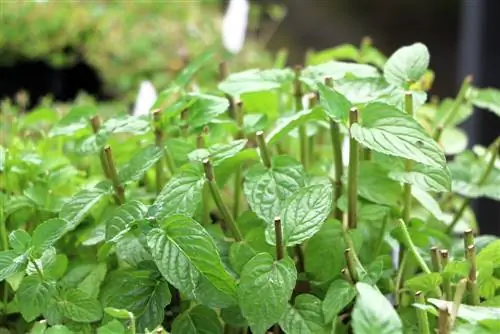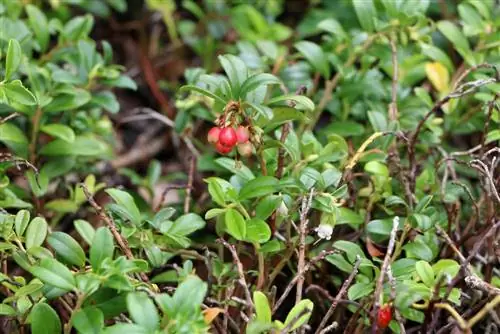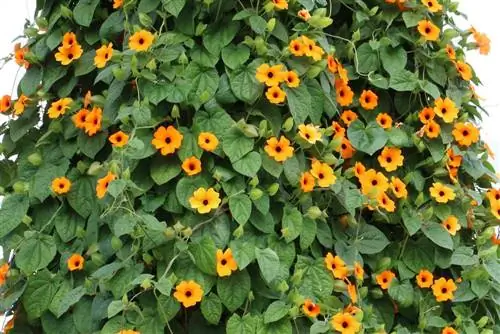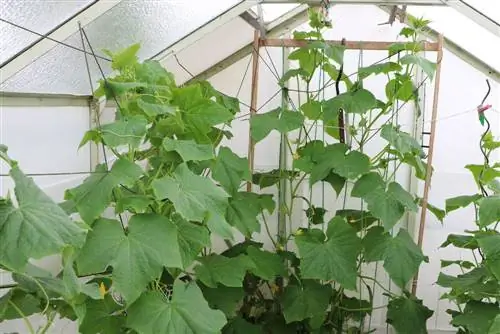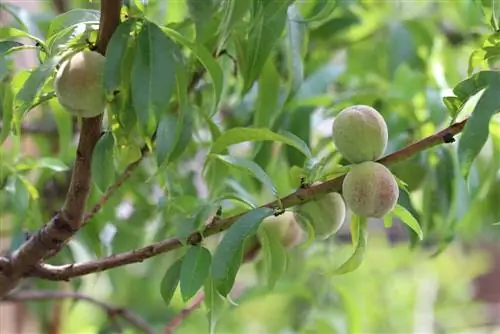- Author admin [email protected].
- Public 2023-12-17 03:39.
- Last modified 2025-06-01 06:48.
Peppermint grows very well in Central European gardens. The herb is not that demanding, likes it moist and airy, does not necessarily need a sunny location and is just as happy with fertilizers as it is with naturally nutrient-rich soil outdoors. Winter-hardy and propagated all year round by division, peppermint is extremely easy to keep. It's just the expansive behavior of the plants that bothers some hobby gardeners - if you don't contain the peppermint, you'll soon only have peppermint in your garden. The herb can be used dried or fresh and is very fine as a tea, spice and decoration.
Location and light
Peppermint doesn't like full sun; it prefers a semi-sunny place or a place with a lot of shade. The plants need a lot of air because they like moist soil. Rain doesn't bother them, not even a lot of rain, as long as the leaves can dry well in the fresh air afterwards and don't stay wet for long. The latter leads to rot. If the peppermint is kept in a pot, the location should also be chosen accordingly - on the balcony, on the terrace, in the winter garden and on the windowsill, the plant does not need full sun, but it likes the gentle sun in the morning and evening. It can cope with moving without any problems, so it can be brought indoors in cool or extremely hot weather without being damaged.
Floor
Peppermint needs nutrients; the plant does not thrive on poor soil. But too much fertilizer is not good either. In the open field, a nutrient-rich mixed soil is optimal; in the bucket or pot, the peppermint needs to be fertilized occasionally (sparingly). The soil should be moist, but not boggy; waterlogging is not good. A humus-rich soil, sandy or slightly loamy soil is fine. There must be a lot of soil in the bucket or pot (herbal soil is well suited), because peppermint grows quickly and likes to take up a lot of space. This can be annoying outdoors - if growth is not contained, all neighboring plants will quickly be displaced. In pots and buckets, this means that the peppermint is repotted every year and, if necessary, divided, otherwise they will simply sprout shoots beyond the pot and look for a new home in neighboring pots. This can be prevented outdoors with a root barrier.
Neighboring plants - good and bad conditions
Peppermint gets along quite well with other mint plants in the neighborhood. Since the plants in this group are all very expansive and like to conquer new territories, they keep each other in check. Chamomile and peppermint, on the other hand, should never sit next to each other, they don't get along at all.
Transplanting
In pots and outdoors, peppermint is replanted every two to five years to allow the soil to regenerate. The soil in which the peppermint has been sitting should not be used for mint plants for the next four or five years, even outdoors. If the peppermint needs to be propagated when transplanting, this can be done by simply dividing the plants.
Propagation - dividing or via cuttings
Peppermint is very easy to propagate, even without seeds. The plant can be easily divided all year round, either as is or when transplanting. It grows easily in the new location and there are usually no problems with divided plants. However, cuttings are only used in spring.
Watering and fertilizing
On warm summer days, peppermint must be watered even outdoors. The plants need moisture, not only in the soil but also on the leaves. There should always be enough moisture in the pot and bucket. However, peppermint does not like waterlogging, and permanently wet leaves lead to rot.
Peppermint does not need to be fertilized often, it does not need highly nutrient-rich soil. Occasional fertilizer applications are therefore completely sufficient. Since peppermint is a culinary herb and is consumed or brewed as a tea, an organic fertilizer is recommended. Horn shavings, natural guano (also available in organic quality) or nettle manure are very suitable. However, you must not over-fertilize.
In the pot and bucket, the peppermint needs a drainage layer in the soil so that excess moisture can drain away. You have to think about that when potting. This is also important when propagating and repotting.
Winter pruning and overwintering
In autumn, the peppermint is cut off close to the ground and the stems and leaves are almost completely removed. This second “harvest” does not have to be thrown away, but can be dried in an airy place out of direct sunlight and used for infusion drinks. The plants are generally winter-hardy and do not need to be taken indoors. If the winter becomes too severe, the pots and containers can also be moved to a cool room. It is important that the peppermint is not kept warm in winter; the plants need the winter rest phase. Outdoors, the plants can be covered with gauze or fleece on particularly frosty days, but this is usually not necessary. Pots and buckets can be wrapped with bubble wrap, placed on a Styrofoam plate and covered with fleece.
Pruning and harvesting
Like all types of mint, peppermint tends to overgrow the entire garden if there is no root barrier. In spring and summer, in any case before flowering, the leaves of the herb are very aromatic and can be used in the kitchen when pruned. To do this, individual shoots are cut off directly above a pair of leaves, or the entire shoot is cut off close to the ground. If the plant becomes too large, the shoot and root can also be removed from the ground. However, the root cannot be used in the kitchen.
Tip:
Even if it is practical in the garden to keep the mint plants in check: planting different types of mint next to each other is not so clever. Because varieties such as chocolate mint, apple mint, Moroccan mint and peppermint (these are the most important types) taste very different. If the plants grow right next to each other, they cross each other, can no longer be told apart, and of course the tastes also mix. If you value variety in taste, keep the plants in your garden strictly separated.
Peppermint as a medicinal plant?
Peppermint as “Medicinal Plant of the Year 2004” can do more than just good for your stomach. This Mentha piperita has a sharp taste (that's why it is also called "pepper" mint), which is evidence of a particularly high menthol content. The essential oil is the most important active ingredient; it also contains tannins, flavonoids and other substances that give the substance complex warming, antispasmodic, antimicrobial and antiviral effects.
This makes peppermint ideal for use against a whole range of ailments: the essential oil is praised as a soothing rub for migraines, headaches and nerve pain, and is added to the steam bath for inhalation when you have a cold (with the subjectively perceived cooling effect being the benefit Mint probably doesn't actually have a decongestant effect), it's supposed to stimulate bile flow and bile juice production, help with virtually any problem in the digestive tract and even have an anti-inflammatory effect. The active ingredients also have a slightly calming effect, which is why peppermint can be found in nerve-calming and sleep-promoting teas, and as a bath additive they are said to cleanse the skin. People who suffer from heartburn with severe acid reflux should exercise caution when using peppermint; this could be made worse by peppermint. Infants and small children should only be cautiously exposed to the strong-smelling essential oil.
Caution: Peppermint tends to take over in the garden
Mint is not only robust and easy to care for, but also a true propagation artist: all mints like to develop underground root runners, so if the soil suits it, the mint could colonize larger and larger parts of your garden over time if it was able to spread unhindered.
But if you like exactly this spreading tendency because there is always more to harvest in your garden without any work, you don't need to limit yourself to Mentha piperita: There are many types of mint, orange mint, lemon mint, basil mint, Strawberry mint, spearmint mint and Japanese mint and more, all of which have their material and taste characteristics.
Frequently asked questions
How do you propagate peppermint?
You can buy seeds and sow them in spring, even outdoors. Peppermint is a light germinator, so the seeds are only pressed onto the loose soil and not covered with soil. Otherwise, peppermint can be propagated by division and cuttings.
What to do if the leaves become spotty?
Peppermint is not that susceptible to diseases and pests, but if it is too moist, fungal diseases will spread. In this case, it helps to transplant the plant to a very airy location and make sure it is moist but not wet. Species of mint with hairy leaves are less susceptible to disease than other species.
How to get cuttings?
In early summer, the very strong new shoots can simply be cut off - these are ideal cuttings. They should be about 15 cm long. The lower leaves are removed, the cuttings are placed in moist, sandy soil and are not allowed to be exposed to the blazing sun until they have rooted.
What you should know about peppermint in brief
Growing in the garden
- Peppermint should be planted in a humus-rich spot that is neither waterlogged nor dried out.
- It is also very important that this area is kept free of weeds, as the peppermint plant builds up a dense root system with very shallow roots.
- The chosen location should also be in partial shade; the peppermint plant has no other requirements.
Harvest
- The leaves and shoot tips of the peppermint plant can be harvested immediately after discovery.
- However, the time before flowering is the most productive harvest time.
Usage
- Peppermint tea
- Seasoning for sauces and salads
- Natural remedies for abdominal pain and stomach problems
Gourmets make extensive use of the peppermint from their garden: every table water includes a few fresh mint leaves, peppermint tea is drunk cold and warm and perhaps with other herbs in it, peppermint leaves go into the mojito and many other cocktails. The plant can also be used as a liqueur, in candies, ice cream, chocolate and sauces.

